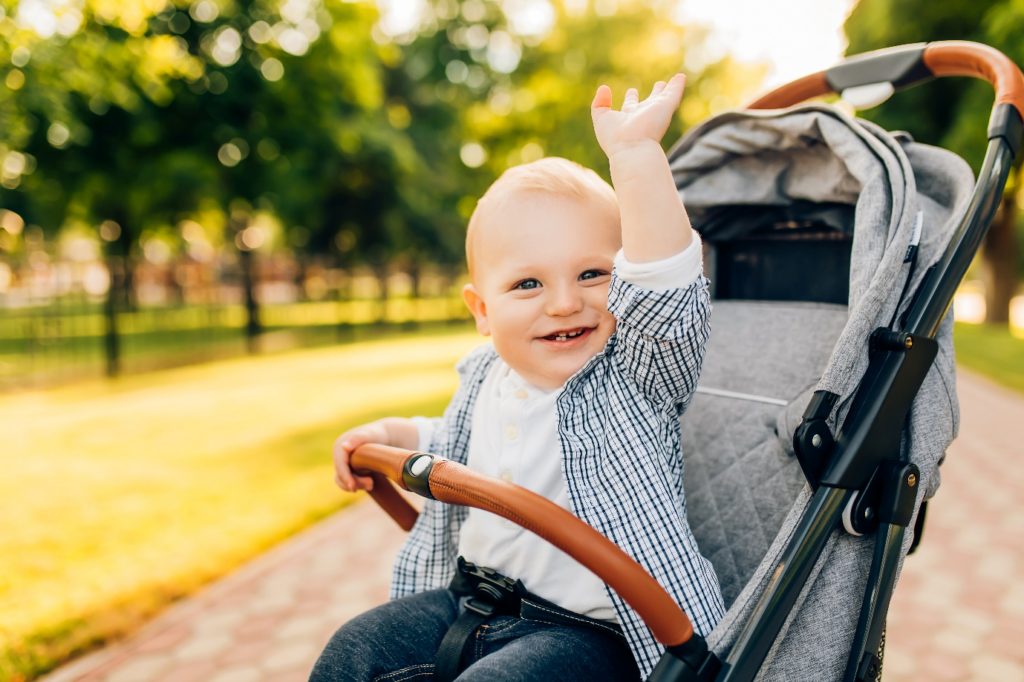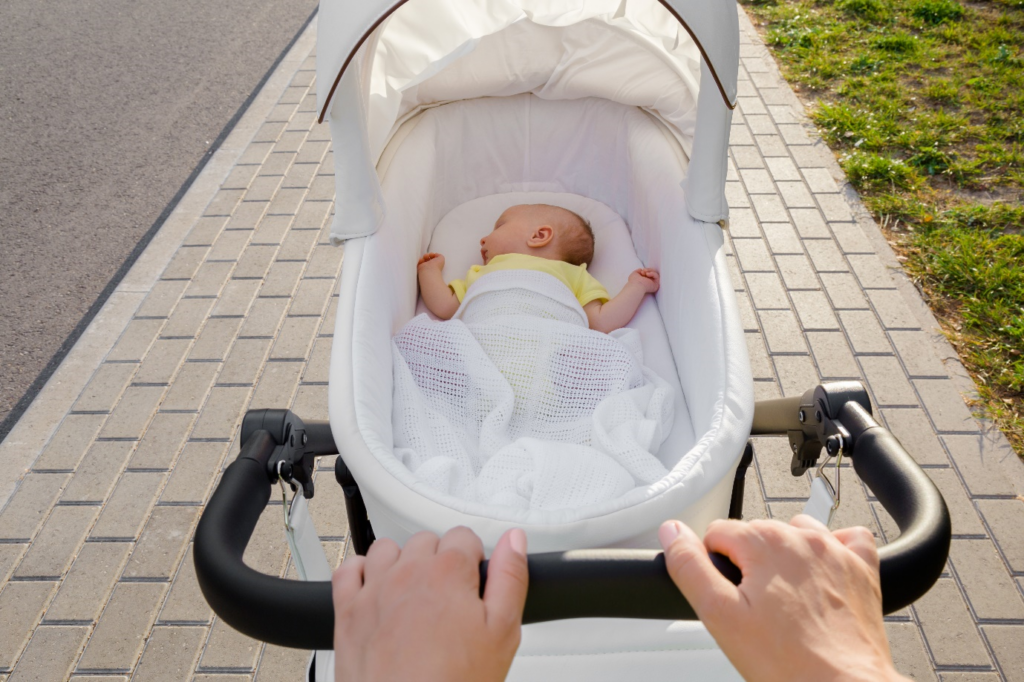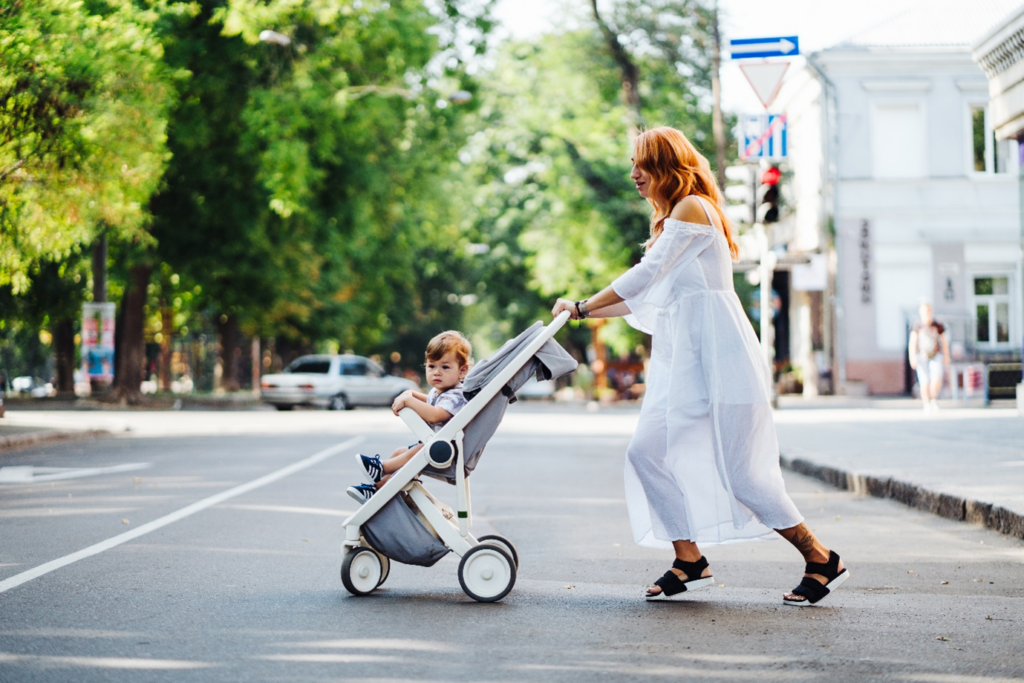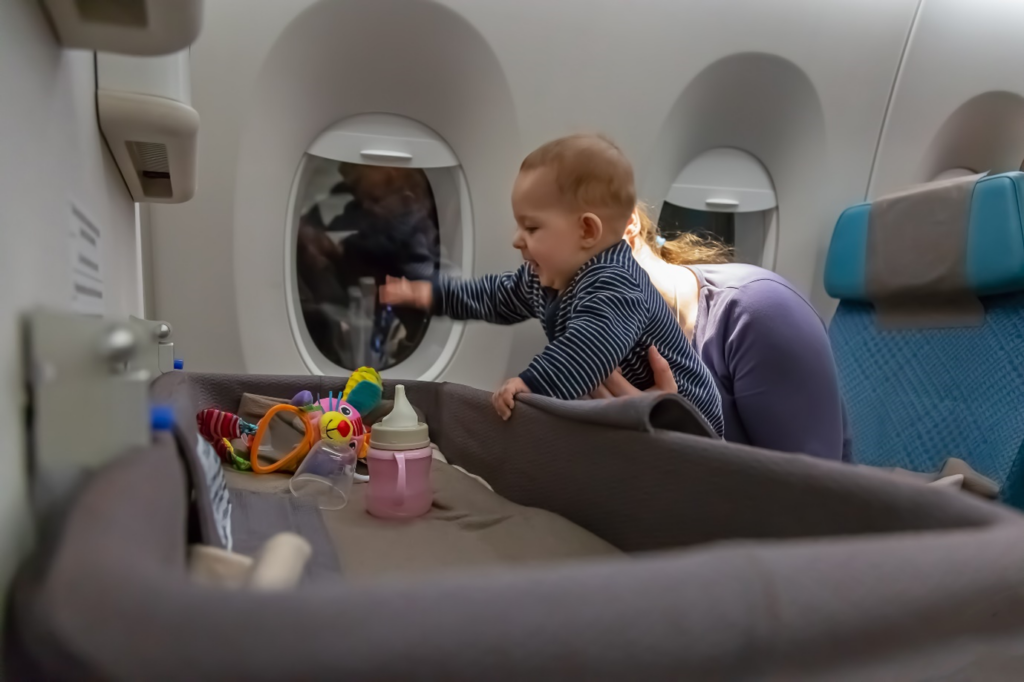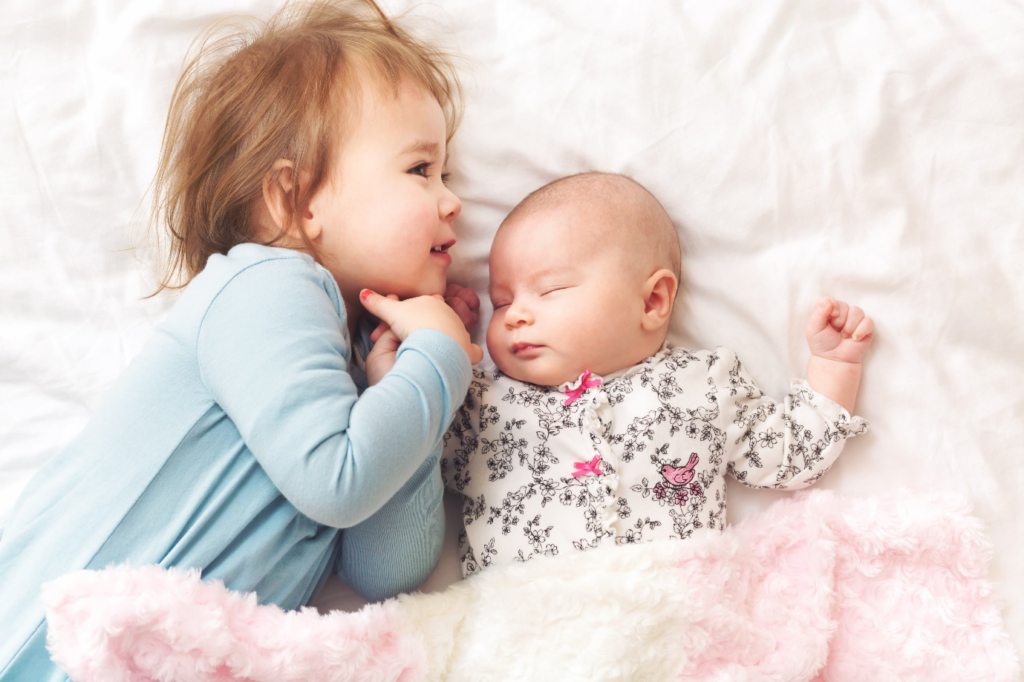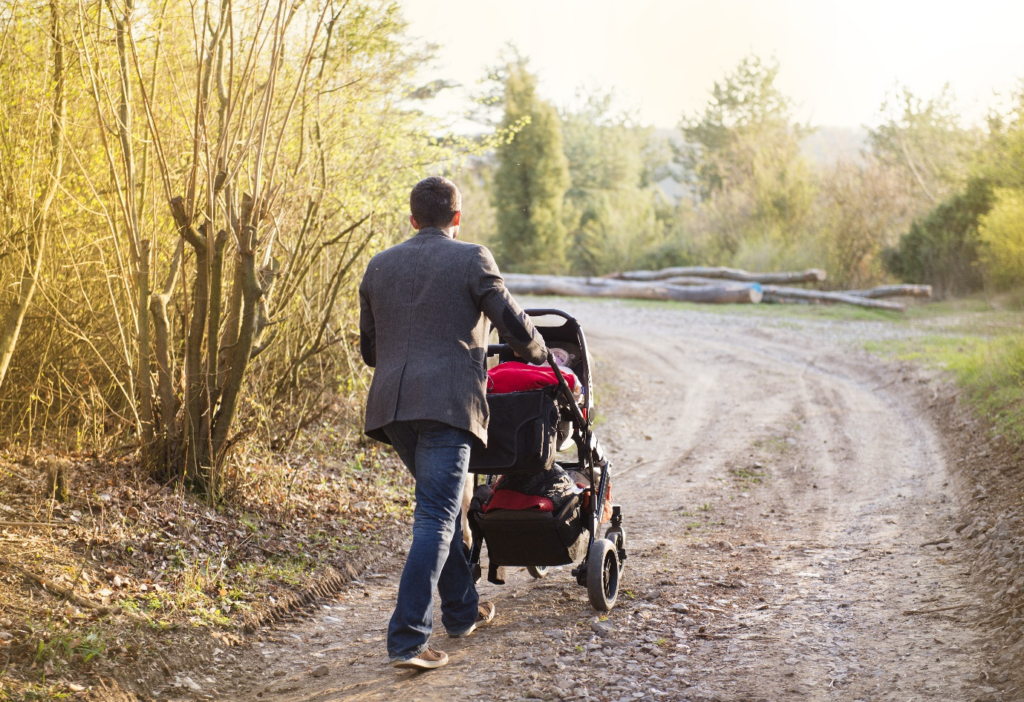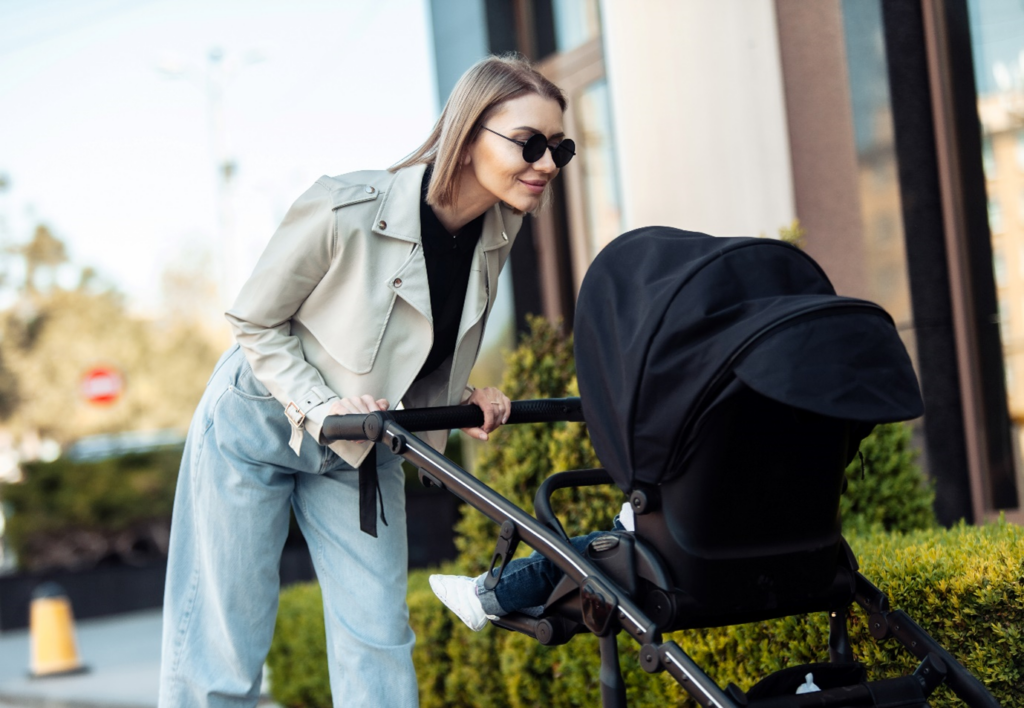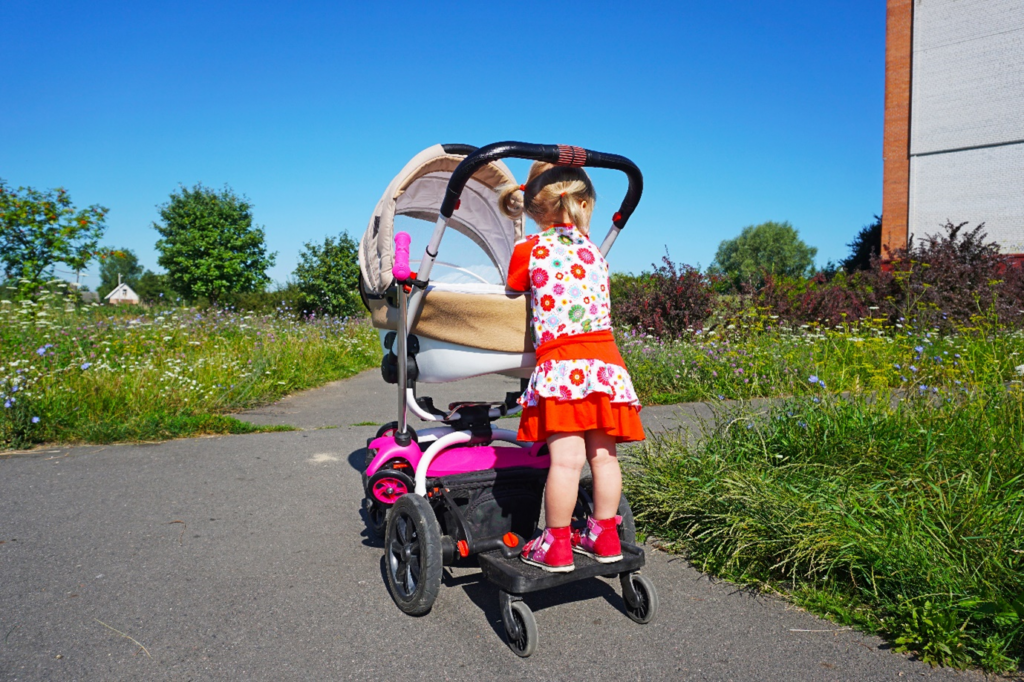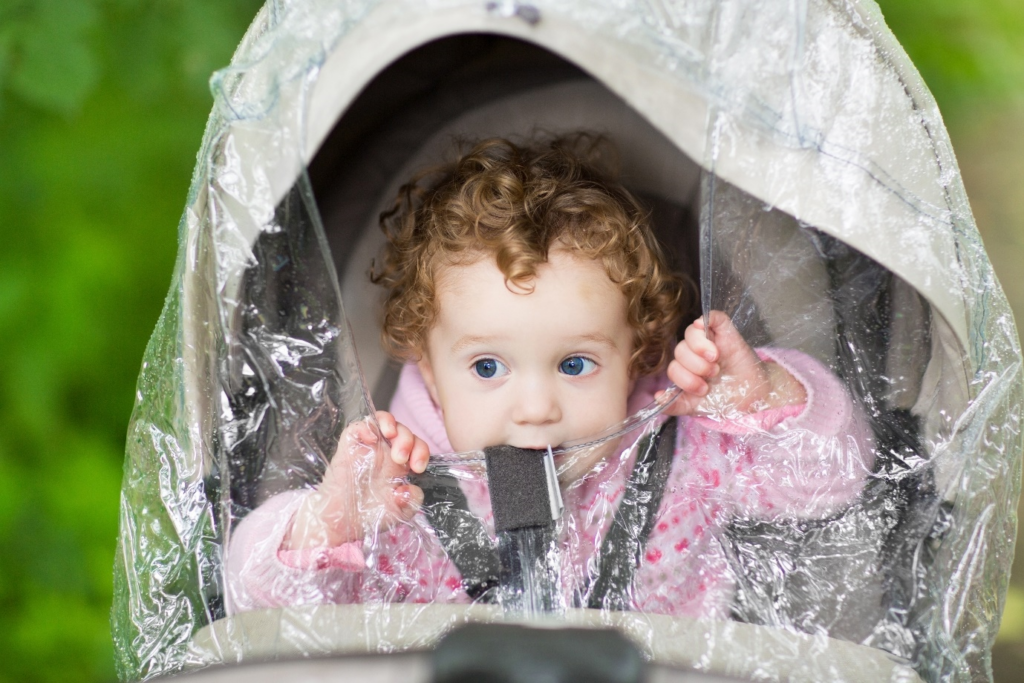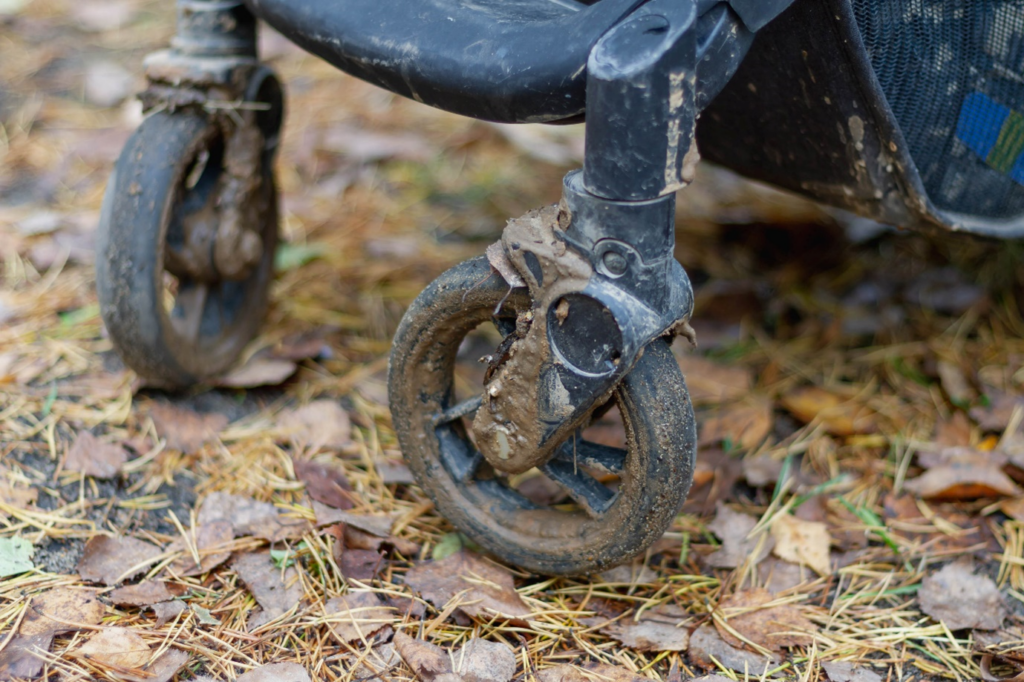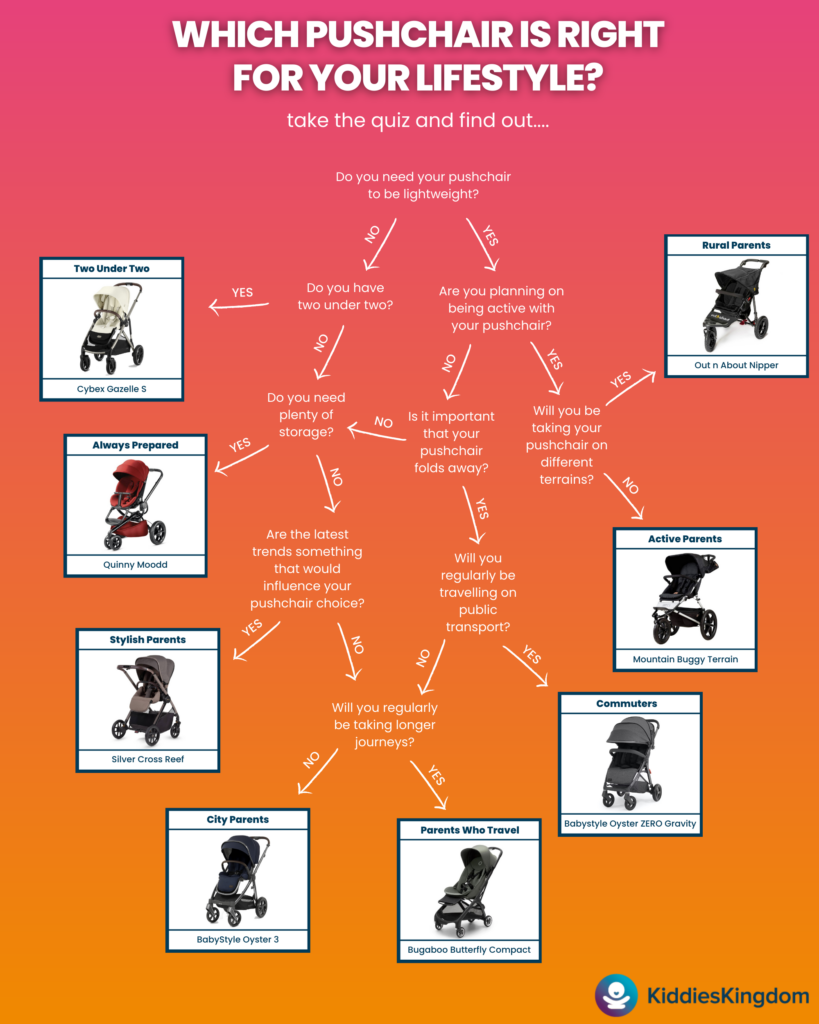The time has come to start thinking about the set of wheels you’re going to be pushing your little one around in. But a quick Google search for this can often leave parents feeling more confused than they did to begin with, no thanks to all the different terminology out there. All sorts will start running through your head. Do you need a pushchair or stroller? Or do you need a buggy or pram? Is there any difference between them all? It can soon become a minefield that leaves you feeling a tad overwhelmed. In short – yes there’s a difference.
We’ve created this buying guide, using insight from our own in-house experts on the best prams, pushchairs, and strollers for each type of lifestyle. By the end of this, any confusion in your mind will be cleared up, and you’ll be able to pick the best set of wheels for your baby, lifestyle, and budget.
Pushchair vs. Stroller vs. Buggy vs. Pram: The Difference
First things first, let’s bust some of that jargon and demystify the differences between a pushchair, stroller, buggy and pram. The most important thing to remember is the word ‘pushchair’ is often used collectively to describe the different sets of wheels out there. In the UK, you’ll find that different regions in England may refer to a pushchair in different ways to each other. As well as this, we also often use the terms interchangeably. However, all of them actually serve a slightly different purpose, so it helps to know the difference before you shop around.
We’ve broken it down for you below with the more standard definitions:
What is a pushchair?
A pushchair is a folding seat on wheels. It’s ideal for older babies from around 6 months old. A good way to judge if your little one is ready for a pushchair is to see if they’re able to sit up unaided. Generally, a pushchair also offers the option for your baby to be forward-facing too, so they can see the world around them.
The benefits of a pushchair include:
- Easy to transport and manoeuvre
- Seat can be adjusted to be parent-facing or forward-facing
- Some models can be changed into a double pushchair
- Seats can offer recline options
What is a pram?
Prams are designed for newborn babies (0 to 6 months old) and offer a modern take on the traditional baby carriage, where your baby can lie flat. This means teeny tinies can snooze in a more natural position throughout those early months, which is advised to help with lung and spinal development.
The benefits of a pram include:
- Parent-facing position means parents can always keep an eye on their babe
- Sturdy build comfortably supports baby’s body
- Some models can be changed into a pushchair once baby is older
What is a stroller?
A stroller is an American term that’s used to describe essentially a lightweight version of a pushchair, and they’re designed for older babies or toddlers. Strollers are often easier to carry around, and they’re also more compact when folded up, in comparison to pushchairs and prams.
The benefits of a stroller include the following:
- Lightweight
- Compact fold
- Ideal for holidays
What is a buggy?
A buggy can be both a pushchair and stroller, although it’s more commonly used to refer to lightweight strollers. Basically, it’s ‘a vehicle’ for your little one.
Price Points: How Much Can Parents Expect to Spend
Safety and comfort are super important considerations but with costs varying all the way from £50 to well over £1,500, you may be wondering if paying more really gets you a better model – and not necessarily.
From the Baby Jogger City Tour 2 Stroller priced at £227 to the Venicci Tinum Upline Pram at £999, costs can go from one extreme to another. However, both of these pushchairs offer a quality set of wheels for your littlun. All it comes down to is yours and your baby’s needs, and what necessary features are included, for you to be able to determine which is right for you.
You could spend well over £1,500 on a pushchair for your child, and whilst they deserve to be treated like a little princess or prince, you’ll be relieved to know that you don’t need to spend this much to get a good set of wheels. Phew!
We advise setting your budget first and then looking at prams, pushchairs, and strollers that are within that price range. A good pushchair which provides interchangeable seats, so you can use a carrycot or a reclining seat that’s suitable for a newborn, is likely to cost you at least £200 to £300.
Choosing the Right One for You: Lifestyle Considerations
For the urban parent…
If you live in an urban area, or you’re just planning on taking a city break with your little one, you’ll need something that’s suitable for this type of environment. It also needs to be compact and easy for you to be able to get on and off public transport.
A lightweight stroller is the answer to all city-lover parents’ prayers. It’s a forward-facing, lightweight option, which takes up much less space than the average set of wheels. A stroller can be used as a travel buggy, and eventually replace a bigger pushchair as your baby or tot becomes a not so little one.
Take the BabyStyle Oyster 3 City Stroller (suitable from birth due to its lie-flat recline) for example – it folds with the seat attached in both directions, making it practical and easier to travel with. It’s a great stroller for city life as it’s very smooth on pavements. Plus, it’s easy to mount kerbs with ease of manoeuvrability in an urban environment, for example getting in and out of shops. All 4 wheels of the Oyster 3 City are a decent size too, which means this stroller will handle itself well in cities, but also in parkland too.
The Silver Cross Dune Stroller (suitable from birth to 22kg (approx. 4 years) is also a good option for urban parents. If the city is your stage, this stroller will become your new best friend. Designed with the contemporary family in mind, it gets around nimbly on busy city streets. Thanks to the Dune’s first-class engineered, independent four-wheel suspension, you can trust this stroller to take on urban life effortlessly, whether you’re tackling bumpy pavements or going on a stroll in the park.
For the wanderlust-seeking parents…
If you love holidaying abroad, you may be wondering “can you take a pushchair on a plane?” – and the answer is yes absolutely! However, hopping on and off an aeroplane can be a challenge even without a pushchair in tow. So, if you’re the type of parent who loves to travel, you need to choose a lightweight, compact stroller.
Say hello to the Bugaboo Butterfly Compact Folding Pushchair (suitable from 6 months+, up to 22 kg). Wherever your adventures take you, the Bugaboo Butterfly will make the ride a whole lot smoother. Whether you’re hopping on a train or jet setting on a plane, this ultra-compact pushchair folds and unfolds in seconds with minimal effort. Plus, it’s approved as cabin luggage and can slide into overhead lockers as easy as ABC. The size also comes in handy for narrow areas like aisles, so you never have to worry about whether your pushchair is going to fit.
Light as a feather at 6kg, the Joolz Aer+ Stroller (suitable from 6 months+) makes travelling easy peasy. The brand promises that the Aer+ is “more than just a buggy” – it’s a premium travel stroller designed with you and your little one in mind. Whilst this stroller is great for those who have the travel bug due to its size and weight, it would also make a brilliant everyday stroller because of how well it moves across different terrains.
For the fitness-fanatic parents…
If you think that having a baby means you can’t venture off the beaten track or keep on top of your health and fitness – think again! An all-terrain pushchair or all-terrain stroller will be your secret weapon here.
The Mountain Buggy Terrain Stroller (suitable from birth to approx. 5 years old) is built to go anywhere with you and your cherub. Staying true to what a mountain bike provides with its air-filled tyres, it comes with a pair of 16” and 12” rear wheels to go from mountain trail to shopping centre in a matter of seconds. If you’re a runner at heart, you’ll be pleased to know that the front wheel has an adjustable tracking device for precision steering and maximum stability, so jogging with your tot will feel like a breeze.
The Out ‘n’ About Nipper Sport (suitable from birth to 4 years, but from 6 months+ for jogging) is a true workhorse that can accompany you on all family days out. Air-filled tyres, independent rear suspension, and a reasonably compact size for a rugged off-roader, means both you and your tot can effortlessly get around both the city and scenic all-terrain routes. It’s perfect for running too, as it has larger wheels and a fixed front wheel.
If you want to know more about being active as a parent, last year we teamed up with Women’s Fitness Specialist and Founder of MAMAWELL – Rosie Stockley. She shared her insights into everything you need to know when running with a baby.
For the parents who commute…
If you’ve ever battled to get your pushchair up and down stairs and escalators, and onto a train or bus, you’ll know that not all are easy to move around with you on a day-to-day basis. Whilst some are a breeze to fold with just one hand (even with a tot and your weekly shop in the other), others just prove to be not up to the challenge. A lightweight, easy to use stroller will be a blessing in disguise if your lifestyle means you have to hop on and off public transport a lot.
Thanks to its easy ‘gravity fold’ which free stands by itself (watch the fold in action), the lightweight, Babystyle Oyster Zero Gravity (suitable from birth to 22kg) is the perfect stroller for parents who commute. It’ll keep your little one company from baby to toddler, with a super spacious and comfy, fully reclining seat. The stroller’s lockable swivel wheels are agile and puncture-free, so you can have peace of mind that getting on and off public transport will be a doddle.
The Joie Nitro Stroller (suitable from birth to 15kg, approx. 3 years old) is also another good option for parents who commute regularly. Its ‘umbrella fold’ makes it perfect for taking on public transport, as you can collapse it down to a small and compact size. This stroller even has its own strap so you can sling it over your shoulder whilst holding your little one.
For the parents with a second child on the way…
If you’re planning on expanding your family tree, convertible pushchairs are like magic. They can be taken from having one seat to two, and sometimes even three. The bonus here is that since you need to buy only once, it means you save money in the long run too – what more could you want?
The Cybex Gazelle S (suitable from birth to approx. 4 years old) is a fantastic option for growing families, as it can hold a total of three little ones at once. Its foam-filled rubber tyres and all-wheel suspension are to thank for its ease of manoeuvrability. The Gazelle S will tackle bumps with no problems, so you can trust us when we say there’ll be no wobbling or shaking in sight. Whilst you’ll likely feel the weight of your littluns, the pushchair doesn’t become heavy, so your children will feel completely secure whilst riding. It’s also compatible with Cybex car seats, Maxi-Cosi Mico 30 car seats, and Nuna Pipa car seats.
For wherever life takes you – meet the Bugaboo Donkey 5 Duo Pushchair (suitable from birth to approx. 4 years old). You can convert this pushchair from single to double in just three clicks and keep your little besties side by side from birth to toddler. The reversible seats let your children face each other, face you or face the world ahead of them. It’s smaller than you’d expect, and ready to go with just a one-hand push. So, what are you waiting for?
For the parents who live in the countryside…
If you live in the countryside, you’ll need an all-terrain pushchair or all-terrain stroller. Whether you’re planning some off-road family fun or taking the dog out, an all-terrain is designed to keep your chick comfy even when the ride gets a little bumpy.
The Out ‘n’ About Nipper Single (suitable from birth to approx. 4 years old) is perfect for country trails. The front wheel can be locked into a forward-fixed position which is ideal for getting out and about in the countryside. Aside from muddy fields, it can be used in lots of other places that are impossible for standard pushchairs to travel on, for example the beach.
Get ready to conquer the country terrains with your bub thanks to the Bugaboo Fox 5 (suitable from birth to 22kg, approx. 4 years old). The robust yet lightweight chassis and puncture-proof wheels, give you complete control when you’re on those bumpy, countryside roads. Plus, in line with the brand’s “push to zero” commitments to be net-zero by 2035, each feature of the Bugaboo Fox 5 has been designed to reduce its environmental impact as much as possible. So, you and your family can navigate the countryside with ease whilst being green as ever.
For the stylish parents…
For those amongst us who are not only after functionality but are also style-conscious, there are lots of stylish prams, pushchairs, and strollers on the market. These days, you can bag a set of wheels which offer both quality engineering and fetching designs, so there’s no reason why your mini fashionista can’t be comfortable and safe whilst being transported around stylishly.
The Silver Cross Reef (suitable from birth to approx. 4 years old) is as beautiful as it is functional. Newborn-ready from the get-go, the Reef has been designed from fabrics that look and feel luxurious yet match up to everyday life. Not only that, but the Reef is sustainable too. Inspired by a love of nature, there are 35 bottles in the seat unit and 12 bottles in the first-bed carrycot. Style and sustainability in one? The best of both worlds!
The ultimate pushchair for first time mums and dads is none other than the iCandy Peach 7. It’s suitable from birth (with carrycot) up to 25kg (15kg on elevators). It’s a deluxe single to double pushchair, combining both beauty and practicality together, to offer parents something designed to fit perfectly around them and their mini me. The Peach 7 is made from soft, modern, and premium knitted jersey materials, which have been tailored to perfection and guarantee cosy comfort for little ones, and style for parents.
For the always prepared parents…
For many parents, preparation is key. Having everything you need to tackle any situation makes everything easier when adventuring out of the house with your little one.
The Quinny Mod Black Frame Pushchair (suitable from birth to 15kg) is ideal for parents looking for extra storage to safely house all of their essentials. The lightweight frame is easy to fold, and automatically unfolds when you need it to, saving precious time on the go. This bold, colourful pushchair has an adjustable footrest and height adjustable handlebars to ensure maximum comfort for you and your baby. The foam filled comfort tyres provide extra comfort, with lockable swivel wheels to enjoy a smooth and bump free ride. Parents can also make the most of a a large, colour coordinated shopping basket to hold up to 5kg of life necessities.
Special Features
Alongside nappies and bottles, your pushchair is likely to become one of your most used baby essentials. It’s also the one that you’ll probably use for the longest, so it’s important to think about the finer details that will make everyday life easy and comfortable for you and your tot.
What to look for (for baby)
- Comfortable padding – extra padding will keep your baby comfortable, snug, and supported. Ergonomic support is available in a lot of pushchairs, offering added protection for your precious littlun.
Ride-on board – this is a good option for families with a new baby as well as a toddler who’s walking but still needs a helping hand when they get tired. Ride-on boards are normally bought separately and can be attached onto the chassis of a pushchair, giving your tot a safe platform for them to stand on. Some boards even come with a saddle, so your child can sit down too.
What to look for (for parents)
- Adjustable handlebar – this will be beneficial if you or your partner, or anyone else who may also use the pushchair, are all different heights.
- Foldability – all pushchairs are foldable but the way that they fold will be different from model to model and across brands. When it comes to foldability, think about which lifestyle above fits yours the most – does the fold need to be compact or one-handed? You’ll also need to think about the weight of the pushchair when it’s folded, and whether it’ll need to be carried up stairs on public transport, or popped into an overhead luggage compartment.
- Shopping basket – these can vary in size so it’s important to factor in your lifestyle. It’s also important to consider whether your goodies will be safe and secure in the basket, so look for one with a large capacity for stashing bags and baby essentials.
- Convertibility – a convertible pushchair can be used interchangeably between one, two, and sometimes even three little ones. It’s an economical option for first-time parents who plan to have a second bundle of joy soon after baby number one.
- Versatile and durable tyres – depending on your lifestyle, your pushchair may need to be pushed on a variety of different surfaces, from grass to bumpy pavements. Some wheels are better for town and city life, whilst others are suitable for more challenging environments. You may want to go for an all-terrain pushchair, which is a bit like an SUV car, in that it feels just as home in urban environments as it does off-road.
Accessories
Never overlook the power of pushchair accessories. Trust us, they’ll make day to day life with your bundle of joy a whole lot easier. When choosing a pushchair, make sure to check what accessories are included and which ones you’ll need as additional purchases.
- Carrycot – this is essentially a light portable cot which will have a handle of some kind that can be attached to the chassis of a pram. If your pram doesn’t have a lie-flat seating option, then a carrycot will be needed, as they allow newborns to lie completely flat which is essential for your teeny tiny’s spinal and lung development.
- Rain cover – we all know how unpredictable the British weather can be, and we’re no strangers to the rain here. A rain cover is essential for keeping not only your little one dry but the fabric of your pushchair too. A lot of pushchairs come with a tailored rain cover to guarantee an accurate fit.
- Parasol – made from SPF/UPF 50+ fabric, a parasol is attached to the frame of a pushchair to help shade your bub from the sun. Some pushchairs will come with an inbuilt sunshade and extendable SPF canopies. But if it doesn’t, a parasol will do a grand job at protecting your baby from the sun. A lot of parasols need to be attached using a clamp, so make sure to check if the clamp will be an add-on purchase or included.
Safety Tips
Looking after your little bambino is both a responsibility and pleasure. So, before you strap them into their pushchair, there are safety considerations that you need to make sure you’re aware of. These will not only mean your babe will be secure in their ride, but snug too.
- Check the safety label – all pushchairs in the UK should have a safety label confirming compliance with BS EN 1888:2018.
- Brakes – it’s essential that your pushchair’s brakes are effective and easy to apply, so always check them regularly as you would in a car.
- Locking – all pushchairs have two locking devices to make sure they’re secure whilst in use. When putting your baby or tot into their pram, pushchair, or stroller, always check they’re both fully locked and secured.
- Avoid overloading – even if you have a stable pushchair on your hands, loading the handlebars with bags of shopping is asking for trouble, as it can lead to it toppling over. When looking for a pushchair, check for a wide, solid base, and get a feel for how it handles by testing it out in the shops.
- Know the weight limit – prams, pushchairs, and strollers all have maximum weight limits for their seat and shopping basket. Make sure you know what these are before nipping out and about with your babe, extra baggage, or even another child, in the pushchair.
- Pushchair harness – most will have a five-point harness built in to help keep your cherub safe and sound. It’s essential to use the harness every time your child is in their pushchair. Picking one with a harness that’s easy to do up and undo goes a long way.
- Keep an eye out for pushchair recalls and safety notices – certain models from big brands, like UPPAbaby, have been recalled in recent years due to safety hazards. Stay in the know with the latest recalls and safety notices, so you can spot whether you own a potentially faulty pushchair, and to find out what you can do about it.
- Avoid overheating in sun – some parents cover their pushchair with material to shade their child from the sun and harmful UV rays, however, covering can cause your little one to get too hot. Regardless of what you’re covering your pushchair with, you should never leave your child in a covered pushchair without constant checking and supervision. Remember – the NHS’ advice on babies and sunlight is to keep those less than 6 months old out of direct sunlight anyway.
Being prepared never hurt anyone, so if you want to learn more, we’ve put together a guide on all things to do with pushchair safety.
How to Clean a Pushchair
Pushchairs, strollers, and prams are bound to get plenty of wear and tear over the years, from adventures in muddy parks and on-the-go snacking, to trips to the shops and holidays.
Below, you’ll find our advice on how to keep your set of wheels looking squeaky clean.
How to clean pushchair frame
It’s a good idea to give your pushchair a regular refresh, especially after little messes or snack time. All you need to do is vacuum the fabric using a hand-held vac or get the dustpan and brush out. Then, wipe away using warm soapy water. If wipes are all you have at hand, fear not! Just make sure to double-check that they don’t have oil in them, as this can stain the fabric. Leave your pushchair to air dry in the sun or at room temperature as this’ll prevent the metal frames from becoming damaged.
Some pushchair brands offer a servicing option where you’ll get a safety check and a deep clean – music to any parents’ ears!
How to clean pushchair fabric
Whether the materials of your pushchair can be machine washed or not will vary according to the manufacturer, so remember to always check the washing instructions. If the fabric can’t go in a washing machine, simply spot clean with water and gentle soap. Air drying in the sun or at room temperature is best for the fabric.
How to clean pushchair wheels
If your pushchair’s wheels are removable, you’re in for a treat, because it’ll make getting it sparkly a whole lot easier (and it offers the most effective clean). You can get rid of wet mud using a hose or pressure washer. For dried mud, we recommend trying a stiff brush. Use a mixture of warm water and washing up liquid, and give the wheel a good scrub.
After the chrome parts dry, buff them up and spray WD-40 on the moving parts. Once you’ve done all this, make sure to also check that your pushchair is still working properly.
How to clean pushchair hood
Start by vacuuming the fabric hood using a small attachment. Then, rinse or soak it in cool, soapy water, and gently work on any stains or tougher areas using a soft, fabric brush. Let the fabric dry thoroughly before you start using it again.
How to clean mould off pushchair
If your pushchair has been tucked away in storage for a while, it may have become damp and mouldy. Maybe you have a second bundle of joy on the way, and you want them to have all the same amazing memories their big bro or sis had in the same pushchair. Just brush off any loose mould and mildew with a soft brush – make sure to do this outside to prevent the mould from spreading. Wash the fabric with a mild detergent and warm water, then leave it to dry in the sun.
For those harder and tougher mould stains that just don’t seem to be budging, we’ve got just the trick. Mix lemon juice and vinegar, but make sure to dilute the solution with water before applying it to your pushchair. And voila – you can say goodbye to those stains forever!
Once your pushchair is as good as new, we recommend buying a seat liner. Whilst it seems obvious, they make caring and maintaining your pushchair a whole lot easier. A seat liner is ideal because it can be easily removed and popped in the washing machine on a gentle cycle, ready for your next adventure with your babe.
Understanding Pushchair Jargon
Buying the first set of wheels for your bub can seem even more complicated than choosing a new car. Apart from the staggering choice of makes and models, the world of pushchairs is also littered with puzzling terminology that can seem like it’s been made to trip up new mums and dads.
Adjustable handlebar
A useful feature to have, it’s designed for parents to be able to adjust the handlebar lower or higher. This is a must for comfort if you and your partner, or granny and gramps, are going to be using the pushchair, but you’re all different heights.
Bumper bar
This sits across the front of a pushchair seat. It’s useful for older babies to hold onto or for you to attach toys onto. Not all pushchairs have them, especially lightweight strollers and sporty three wheelers.
You can also get pushchairs that have removable bumper bars.
Car seat adapters
These click onto your pushchair chassis, so that you can attach a car seat, and voila, you have a travel system! Whether you need these adapters or not will depend on the type of car seat or pushchair you pick, since many models are instantly compatible and fit together without them.
Footmuff (or cosy toes)
A footmuff is a cosy sleeping bag for use in a pram, pushchair, or stroller. It’s perfect for keeping your littlun snug and cosy when those winter months come around. Stylish as well as practical, you can choose from lots of different designs, and many pushchairs even come with matching ones included.
Pneumatic tyres
These are air-filled tyres, which make getting around on rough terrain as easy as ABC. They’re more likely to be found on three-wheelers and jogging strollers.
Quick-release wheels
Like the name implies, these types of wheels can be taken off quickly and easily, reducing the footprint of a folded pushchair, and making storing or fitting it into your car boot a breeze.
Umbrella fold
Lightweight strollers often have this fold. they quite literally close up like an umbrella, and are able to be carried and stored more easily because of this.
Tandem pushchair
This is a double pushchair where its seats are placed one behind the other. It’s better for little ones who are different ages, but keep in mind that one child will always have a more restricted view. The extra length can make getting onto public transport like buses a little trickier, but navigating doorways and narrow spaces will be easy peasy.
Travel system
You can make a travel system with most from-birth pushchairs by connecting a compatible car seat onto the chassis. It’s perfect for trips out, since you can transfer your sleeping angel from car to pushchair chassis and keep them in the same seat without disturbing their peaceful slumber.
Twin pushchair
The seats in a twin pushchair sit side by side and give each of your tots a view of the world before them. They’re better suited to children who are the same age rather than a newborn and older toddler combination.
It’s worth keeping in mind that twin pushchairs are sometimes too wide to go through doorways easily, and getting in and around crowded cafés and public transport can be a little tricky.


